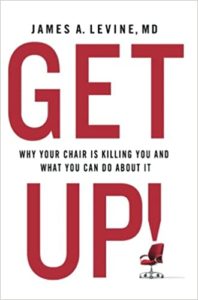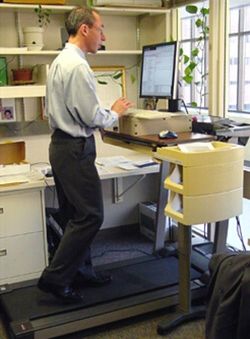This post was last updated on July 13th, 2022 at 09:53 am
You’ve probably heard the saying, “Sitting is the new smoking.” While Dr. James Levine doesn’t take credit for coining the phrase, he’s played a large role in bringing the message into the public consciousness. Through years of research and writings, Levine has been instrumental in educating people about the dangers of sitting too much and the importance of getting up and moving our bodies.
In some circles, debates have arisen over which is actually worse: excessive sitting or smoking. But these debates miss the point, Levine told Frugalmatic during an interview. “These two things are terribly unhealthy, and it doesn’t matter which one is the worst of two evils. Importantly, I’d say the biggest part of the comparison is that with modern science and modern technology, a patient who is a smoker can be helped. And somebody who’s excessively sedentary can be helped. That’s the commonality,” he explained.
Levine is a trailblazer in his field and was raising concerns about the links between sedentary lifestyles and chronic conditions at a time when some medical professionals were still dismissive. Some of Levine’s most influential work, including his book “Get Up! Why your chair is killing you and what you can do about it,” has inspired people, office workers in particular, to break unhealthy habits. His writings helped fuel the rise of standing desks and treadmill desks. Indeed, Levine pieced together his own personal treadmill desk before treadmill desk products existed.
How the slim stay slim: NEAT
Some of Levine’s greatest contributions focus on non-exercise activity thermogenesis, or NEAT. It is a mouthful, but the idea is simple: NEAT is the energy we burn going about our everyday activities excluding exercise. Many people erroneously assume physical activity can only be exercise, but NEAT shows there are many ways to move throughout a day—not just going to the gym.
One of Levine’s most fascinating studies of NEAT was dubbed the Great Gorging Experiment. As Levine describes it in “Get up!”, the study examined why some people tend to gain weight while others don’t. Sixteen volunteers each consumed 1,000 more calories a day than they needed. For 56 days, the volunteers ate three meals a day at a research facility, where calories could be meticulously counted. After each meal, they resumed their normal lives.
What Levine found confirms what many people with active lifestyles intuitively know: Moving throughout the day helps you stay slim. For some participants, those 56,000 extra calories turned into 14 pounds of extra weight while others gained no weight. Levine found that those who stayed slim turned on their “NEAT switch,” burning the extra calories through non-exercise movement.
But it’s about more than weight
To be sure, NEAT’s benefits extend beyond weight control. “Actually it doesn’t matter whether you’re overweight or normal weight. It’s not just body weight,” Levine told Frugalmatic.
For example, walking 15 minutes after a meal can reduce blood glucose levels, lowering levels from a “big mountain” to a “hill of blood glucose.” That’s important because blood glucose changes after a meal are a predictor of type 2 diabetes. “The opportunities are far beyond excess body weight and calorie burning. They’re really core to human health,” Levine explained, adding that NEAT can also benefit mental health.
‘Get up!’ message remains as important as ever
Levine’s book “Get up!” remains as important today as it was when it was first published nearly a decade ago. Studies show the COVID-19 pandemic has reduced physical activity levels worldwide. The pandemic has forced many people, including Levine, to find new ways to add movement to their day. Levine, who is president of the France-based organization Fondation Ipsen, said he views the pandemic as an opportunity to change cultural norms which have kept too many people in chairs.

“This could be the breakout moment in the workplace environment where all of a sudden working-while-moving, working-while-upright could become socially and professionally acceptable,” Levine said.
Read more excerpts from the interview with Dr. James Levine below. Some responses have been edited for clarity and length.
Frugalmatic: I’m curious how the pandemic affected you personally, in terms of physical activity levels. Did you have to adjust your routine much to stay active?
Dr. James Levine: I had to adjust my routine a great deal, but I did stay active. I’m in a particularly fortunate position. We’re talking about the workplace and permissions to be up and moving. That requires a leadership opportunity, for the leaders to say, “It’s cool to be up and moving. It’s cool to be active.” I have that opportunity to be able to conduct meetings while walking. I would take my cell phone and headphones into the woods behind my house and conduct meetings there.
People would say, “It sounds like a running stream in the background.” And I would say, “Yes it is.”
During the pandemic, we all got used to background sounds. So the idea of having healthy, natural background sounds was very positive.
The other thing I did—which I found to be fantastic—and I did this on several occasions was do socially-distanced, face-to-face meetings. We’d literally maintain the social distance, wear masks, and conduct 1- and sometimes 2-hour meetings walking. It showed that there’s no reason that something like this type of confining pandemic needs to tie us down.
It’s all about how we make the mental determination to be more active. Once you make the decision to do it, you will then work out the method to be that much more active than you were.
Read: 4 books to inspire you to be more physically active
F: You’ve been a pioneer in exploring how we can burn more calories through everyday living, especially through your research of non-exercise activity thermogenesis (NEAT). I’m a big believer in its benefits, but NEAT still seems underappreciated. What’s the secret to getting more people to embrace physical activity other than just exercise?
JL: The first comment I’d make is that if you’re somebody who does exercise, who does go to the gym, who does speed cycling, my response to that is, “Good for you. Fantastic. Excellent. Keep doing it.” Not for a second and never would I discourage someone from exercising if that’s what they like to do.

However, many people do not like to formally exercise. Many people do not like to go to the gym. Many people feel quite stigmatized to go to the gym or can’t afford to go to the gym. So what’s important to bear in mind is the activity that you do that’s non-exercise is a big opportunity for people who don’t like to go to the gym.
If I convert two of my meetings in a day (and I generally have 10 to 15 meetings a day) into walk-and-talk meetings, that’s 2 hours of walking. That’s about 300 calories a day, five days a week. That’s 1,500 calories, and I haven’t even gotten to the weekend yet. What you realize is this is a massive opportunity for those that take it. That’s the beauty of this.
There’s really good data on the variance in NEAT in high-income societies. You can have one person burning 1,500 calories a day less than another person of similar size. If you take a couple of hours of walking to meetings, walking to and from work, walking in the evening—you can quickly appreciate how one person can burn 500, 600, 700 calories more than another person who’s sedentary at work and sedentary at home.
That’s really the key message, that this is a massive opportunity for your health.
Check out more Frugalmatic interviews
F: On a related note, how can we promote exercise without medicalizing it too much? I’m talking about this belief that “exercise is medicine.” Because for me, at least, medicine is only something I take when I’m sick. The intentions are good, but I wonder if it sends the wrong message.
JL: Your point is well taken. The idea is that someone with type 2 diabetes goes to the doctor, and what the doctor is trying to do is help the patient get healthier, and so the doctor prescribes exercise. That’s the intent behind “exercise is medicine,” and I think it’s a million-percent brilliant. But the message in the public domain can get misconstrued. All of a sudden exercise is another pill you need to take—how negative.
My comment about NEAT is, in my experience, “If it ain’t fun, it ain’t gonna work.” Walk-and-talk meetings work because both people like them. Walk-and-talk Zoom meetings work because, literally, there’s a tendency to fall asleep on these Zoom meetings. I’m telling you. Walking is guaranteeing that I’m going to stay awake.
To me, if you’re not having fun, you’re not doing NEAT. When you’re active, whether it’s the gym or doing the kinds of things I’m discussing here, if it’s not positive, if it’s not fun, it’s not sustainable. And it’s all about sustainability.


Hello, I’d like to interview Dr. Levine on my podcast for breast cancer patients. Do you have an email for him?
Dear Dr Levine is constant moving manageable for people with type 1 diabetes?
Hi Ann, Dr. Levine didn’t write this piece. I interviewed him, and I wouldn’t be able to give you an answer.